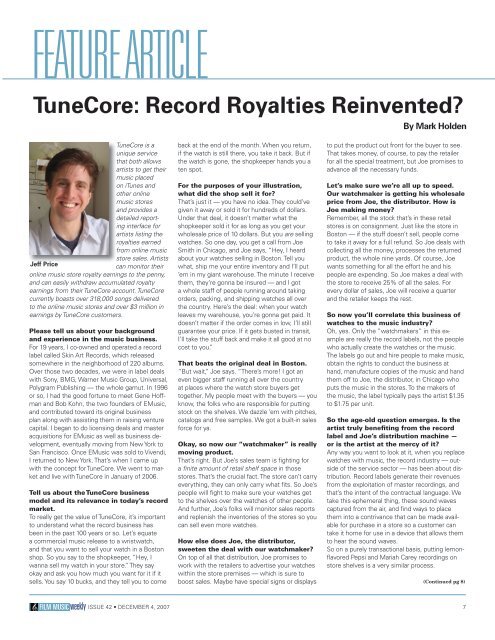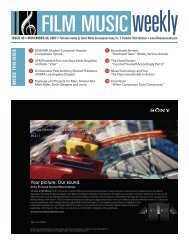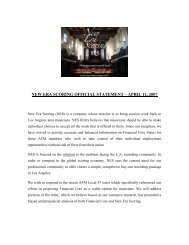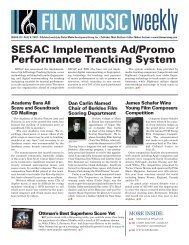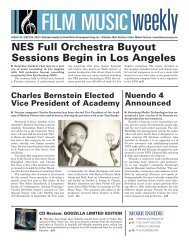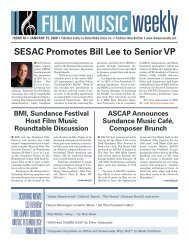Weekly - Film Music Magazine
Weekly - Film Music Magazine
Weekly - Film Music Magazine
You also want an ePaper? Increase the reach of your titles
YUMPU automatically turns print PDFs into web optimized ePapers that Google loves.
FEATURE ARTICLE<br />
TuneCore: Record Royalties Reinvented?<br />
TuneCore is a<br />
unique service<br />
that both allows<br />
artists to get their<br />
music placed<br />
on iTunes and<br />
other online<br />
music stores<br />
and provides a<br />
detailed reporting<br />
interface for<br />
artists listing the<br />
royalties earned<br />
from online music<br />
store sales. Artists<br />
Jeff Price<br />
can monitor their<br />
online music store royalty earnings to the penny,<br />
and can easily withdraw accumulated royalty<br />
earnings from their TuneCore account. TuneCore<br />
currently boasts over 318,000 songs delivered<br />
to the online music stores and over $3 million in<br />
earnings by TuneCore customers.<br />
Please tell us about your background<br />
and experience in the music business.<br />
For 19 years, I co-owned and operated a record<br />
label called Skin Art Records, which released<br />
somewhere in the neighborhood of 220 albums.<br />
Over those two decades, we were in label deals<br />
with Sony, BMG, Warner <strong>Music</strong> Group, Universal,<br />
Polygram Publishing — the whole gamut. In 1996<br />
or so, I had the good fortune to meet Gene Hoffman<br />
and Bob Kohn, the two founders of E<strong>Music</strong>,<br />
and contributed toward its original business<br />
plan along with assisting them in raising venture<br />
capital. I began to do licensing deals and master<br />
acquisitions for E<strong>Music</strong> as well as business development,<br />
eventually moving from New York to<br />
San Francisco. Once E<strong>Music</strong> was sold to Vivendi,<br />
I returned to New York. That’s when I came up<br />
with the concept for TuneCore. We went to market<br />
and live with TuneCore in January of 2006.<br />
Tell us about the TuneCore business<br />
model and its relevance in today’s record<br />
market.<br />
To really get the value of TuneCore, it’s important<br />
to understand what the record business has<br />
been in the past 100 years or so. Let’s equate<br />
a commercial music release to a wristwatch,<br />
and that you want to sell your watch in a Boston<br />
shop. So you say to the shopkeeper, “Hey, I<br />
wanna sell my watch in your store.” They say<br />
okay and ask you how much you want for it if it<br />
sells. You say 10 bucks, and they tell you to come<br />
back at the end of the month. When you return,<br />
if the watch is still there, you take it back. But if<br />
the watch is gone, the shopkeeper hands you a<br />
ten spot.<br />
For the purposes of your illustration,<br />
what did the shop sell it for?<br />
That’s just it — you have no idea. They could’ve<br />
given it away or sold it for hundreds of dollars.<br />
Under that deal, it doesn’t matter what the<br />
shopkeeper sold it for as long as you get your<br />
wholesale price of 10 dollars. But you are selling<br />
watches. So one day, you get a call from Joe<br />
Smith in Chicago, and Joe says, “Hey, I heard<br />
about your watches selling in Boston. Tell you<br />
what, ship me your entire inventory and I’ll put<br />
‘em in my giant warehouse. The minute I receive<br />
them, they’re gonna be insured — and I got<br />
a whole staff of people running around taking<br />
orders, packing, and shipping watches all over<br />
the country. Here’s the deal: when your watch<br />
leaves my warehouse, you’re gonna get paid. It<br />
doesn’t matter if the order comes in low, I’ll still<br />
guarantee your price. If it gets busted in transit,<br />
I’ll take the stuff back and make it all good at no<br />
cost to you.”<br />
That beats the original deal in Boston.<br />
“But wait,” Joe says. “There’s more! I got an<br />
even bigger staff running all over the country<br />
at places where the watch store buyers get<br />
together. My people meet with the buyers — you<br />
know, the folks who are responsible for putting<br />
stock on the shelves. We dazzle ‘em with pitches,<br />
catalogs and free samples. We got a built-in sales<br />
force for ya.<br />
Okay, so now our “watchmaker” is really<br />
moving product.<br />
That’s right. But Joe’s sales team is fighting for<br />
a finite amount of retail shelf space in those<br />
stores. That’s the crucial fact. The store can’t carry<br />
everything, they can only carry what fits. So Joe’s<br />
people will fight to make sure your watches get<br />
to the shelves over the watches of other people.<br />
And further, Joe’s folks will monitor sales reports<br />
and replenish the inventories of the stores so you<br />
can sell even more watches.<br />
How else does Joe, the distributor,<br />
sweeten the deal with our watchmaker?<br />
On top of all that distribution, Joe promises to<br />
work with the retailers to advertise your watches<br />
within the store premises — which is sure to<br />
boost sales. Maybe have special signs or displays<br />
By Mark Holden<br />
to put the product out front for the buyer to see.<br />
That takes money, of course, to pay the retailer<br />
for all the special treatment, but Joe promises to<br />
advance all the necessary funds.<br />
Let’s make sure we’re all up to speed.<br />
Our watchmaker is getting his wholesale<br />
price from Joe, the distributor. How is<br />
Joe making money?<br />
Remember, all the stock that’s in these retail<br />
stores is on consignment. Just like the store in<br />
Boston — if the stuff doesn’t sell, people come<br />
to take it away for a full refund. So Joe deals with<br />
collecting all the money, processes the returned<br />
product, the whole nine yards. Of course, Joe<br />
wants something for all the effort he and his<br />
people are expending. So Joe makes a deal with<br />
the store to receive 25% of all the sales. For<br />
every dollar of sales, Joe will receive a quarter<br />
and the retailer keeps the rest.<br />
So now you’ll correlate this business of<br />
watches to the music industry?<br />
Oh, yes. Only the “watchmakers” in this example<br />
are really the record labels, not the people<br />
who actually create the watches or the music.<br />
The labels go out and hire people to make music,<br />
obtain the rights to conduct the business at<br />
hand, manufacture copies of the music and hand<br />
them off to Joe, the distributor, in Chicago who<br />
puts the music in the stores. To the makers of<br />
the music, the label typically pays the artist $1.35<br />
to $1.75 per unit.<br />
So the age-old question emerges. Is the<br />
artist truly benefiting from the record<br />
label and Joe’s distribution machine —<br />
or is the artist at the mercy of it?<br />
Any way you want to look at it, when you replace<br />
watches with music, the record industry — outside<br />
of the service sector — has been about distribution.<br />
Record labels generate their revenues<br />
from the exploitation of master recordings, and<br />
that’s the intent of the contractual language. We<br />
take this ephemeral thing, these sound waves<br />
captured from the air, and find ways to place<br />
them into a contrivance that can be made available<br />
for purchase in a store so a customer can<br />
take it home for use in a device that allows them<br />
to hear the sound waves.<br />
So on a purely transactional basis, putting lemonflavored<br />
Pepsi and Mariah Carey recordings on<br />
store shelves is a very similar process.<br />
(Continued pg 8)<br />
FILM MUSICweekly<br />
ISSUE 42 • DECEMBER 4, 2007 7


